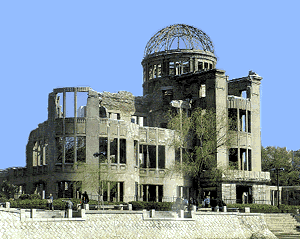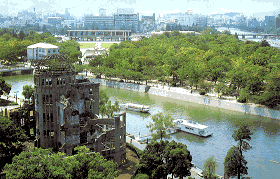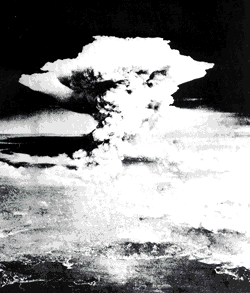 |
| FOREWORD |
|---|
| On August 6, 1945, Hiroshima suffered humankind's first nuclear-weapons tragedy. Since then, nuclear weapons have increased in number and have advanced tecknologically to the point of threatening the existence of the human race. Against this crisis, international public opinion calling for disarmament has intensified, and substantial steps have been taken toward the elimination of nuclear arms. However, a vast number of nuclear weapons exist, and nuclear proliferation remains a grave concern. We must work even harder, redoubling our efforts to eliminate nuclear weapons and establish genuine, Iasting world peace. This collection of photographs records the painfully tragic results of the A-bomb dropped on Hiroshima. I fervently hope this booklet will help people everywhere comprehend the horror of nuclear weapons and the sanctity of peace. |
| Takashi Hiraoka President Hiroshima Peace Culture Foundation |
 |
| The first atomic bomb burst in the sky over Hiroshima on August 6, 1945 and raised the curtain on the tragedy of mankind's entrance into the Nuclear Age. It gave warning that the human race may destroy itself through war. It confronted us with the dilemma we are forced to resolve: "Which shall it be, War or Peace?" For everyone on the face of the earth now compelled to live in the Nuclear Age, the experience of Hiroshima becomes both a warning and a foundation on which to build peace. We of this city deeply feel its awesome and historic meaning. The knowledge and wisdom of all men must be gathered and employed to build eternal peace. The tremendous effort which men now expend on war shall be rechanneled into planning for and building a mutually supportive community. |
 |
| "8:15 A.M. - Atomic bomb released. 43 seconds later, a flash! Shock ware, craft careens. Huge atomic cloud. "9:00 A.M. - Cloud in sight. Altitude more than 12,000 meters." (Part of a flight diary written by one of the Enola Gay crew, who dropped the atomic bomb.) Beneath the huge mushroom cloud glittering in the summer sun lies Hiroshima, looming as the zero point of the Nuclear Age. Casting a dark shadow, the cloud spreads out toward the northwestern sky and soon it pours out the "black rain." Three or four hundred thousand Hiroshima citizens moan beneath this mushroom cloud. A crew member of one of the three B-29's participating in the bombing attack takes a photograph of the spreading cloud, with the Seto Inland Sea and the islands bordered with their white surf down below. High above, they cannot hear the survivors' voices begging for help; the victors leave for home, well satisfied that their task has been completed. |
 |  |